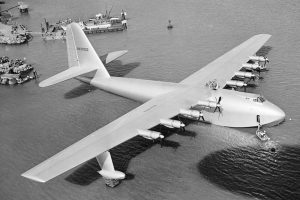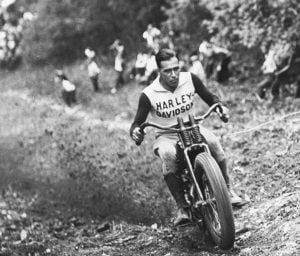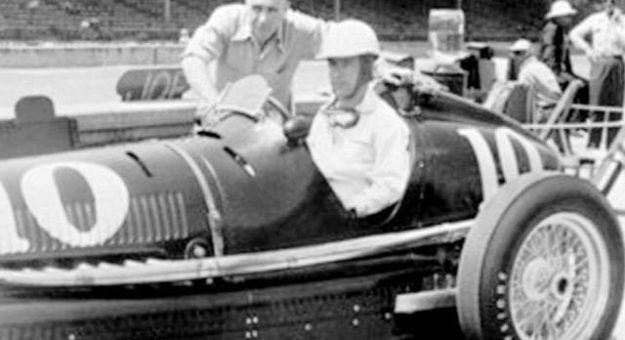When the IRC racing group named Joe Petrali chief mechanic on the former 500-winning Maserati of Wilbur Shaw, observers believed IRC’s rookie driver was a shoe-in for the 1950 Indianapolis 500.
It was Shaw who had urged California midget standout Bill Vukovich to attempt the 500 and asked IRC to put him in the Maserati. But a power-robbing problem developed in the car’s exotic carburetors and without the proper parts for repair, Vukovich couldn’t get the car up to speed.
While Vukovich went on to become a racing legend, Petrali had already risen to legendary status. His mechanical reputation was impeccable. Besides his uncanny ability with racing engines, among other accomplishments, Petrali helped his friend, the eccentric Howard Hughes, develop his engineering brainstorms, including the infamous “Spruce Goose.”

In fact, Petrali was on board the enormous plane’s abbreviated flight, as the flight engineer.
However, Petrali’s most revered racing contributions were as a motorcycle racer. A three-time national champion, he won 49 AMA National events, a record that stood until Scott Parker won his 50th race in 1992.
In 1932, Petrali became the only rider to win both the national Hillclimb and Dirt Track championships in the same year. In 1935, he won all 10 class A National events.
The following year, he became the world’s fastest man on two wheels, pushing his Harley-Davidson streamliner to more than 136 mph. The record stood for 11 years.
Born in San Francisco on Feb. 22, 1904, by age 12 Petrali had already developed a fascination with motorcycles and worked in a Sacramento motorcycle shop.
His passion for racing erupted when he and his buddies pried the boards loose from the fence around the nearby Sacramento Fairgrounds dirt track to peek at the action. Enthralled, he watched fearless riders toss their roaring bikes through the corners. He knew then that’s what he wanted to do.
At 13, Petrali bought his first motorcycle, a 500cc Indian Standard. It cost $35. A year later, he won his first AMA national event, an economy run.
“I weighed about 80 pounds, so I just laid down and idled around for several days,” Petrali recalled. “I went 176 miles on that gallon of gas and won the national economy class for 30 to 50-cubic-inch motorcycles.”

A milestone victory aside, Petrali wanted to race for real. He got his chance during 1921 in Fresno, Calif. “Shrimp” Burns had died in a crash in Toledo, Ohio, the week before. Petrali fudged his age and convinced Jud Carriker, Indian’s Pacific Coast racing manager, to give him Burns’ ride.
He proved so fast that the Harley-Davidson team riders boxed him in for most of the race. Wiser than his 17 years, Petrali retarded the ignition so the engine popped and pretended he was having problems. The Harley riders let up and on the last lap he passed all but the leader.
Yet another crash by a rider opened the door for Petrali’s first national victory. In 1925, he was scheduled to ride an Indian at the insanely high-banked Altoona, Pa., board track, but the motorcycle was inadvertently shipped to the wrong location.
He was resigned to be a spectator until Harley factory rider, Ralph Hepburn, injured his arm during practice. Hepburn enlisted Petrali to take his place for a 50/50 split of the prize money.
Petrali jumped at the chance. Dodging splinters hurled like spears from other bikes, Petrali dueled with Eddie Brinck throughout the race, and took the checkered flag with a record average speed of 100.36 mph for the 100 miles.
After that win, Harley-Davidson snatched him up. For the next 10 years, Petrali was the dominant rider in AMA racing, winning multiple events and two championships for Harley.
Harley exited racing in 1926, so Petrali convinced bicycle manufacturer Ignaz Schwinn to get his Excelsior motorcycles back into racing. That pairing resulted in another national title.
After retiring from motorcycle racing in 1938, Petrali turned to auto racing. He worked as a chief mechanic and then for USAC, verifying economy and speed runs, as well as heading the land-speed record certifications at the Bonneville Salt Flats during the 1960s.
Petrali suffered a heart attack on the road home from an event and died on Nov. 10, 1973. Until his death, he proudly carried and displayed his AMA Life Member Card No. 1.
Petrali was inducted into the AMA Hall of Fame in 1998.

